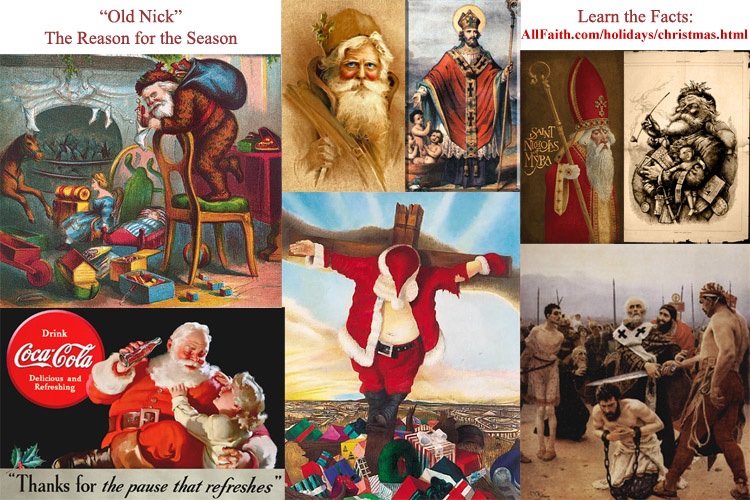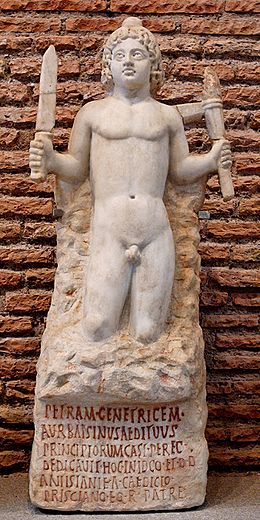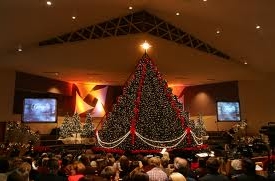Go to: Part 1: The Mother of All Pagan Holidays
Go to: Part 2: The Birth of Y'shua ben Yosef
This is: Part 3: The Real Reason for the Season
Go to: Part 4: The Dark Truth About Santa Claus
Go to: Part 5: Saint Nicholas and the Nicolaitan Heresy
Go to: Part 6: A Christmas Song

Its Yule Ya'll!
The Real Reason for the Season

As I discuss in other studies (many are indexed here), following the horrendous events that occurred between 70 and 72 CE (i.e. the destruction of the Second Temple, the Fall of Masada etc. and the exile of the Jewish people from the Roman Province of Iudaea: Judea: Eretz Israel), many anti-Torah doctrines arose among the followers of the historic Y'shua ben Yosef. We do not know with certainty what Y'shua and his original followers taught, although his teaching were supposed to be completely consistent with Torah (Matthew 5:18). Much of what the Church teaches clearly is not. By the early second century three competing sects were forming, each claiming to be Y'shua's true and authorized successors:
- Jewish Nazarenes: These were primarily born Jews with some Jewish converts. They were called by various names. The Nazarenes (not to be confused with the Nazarites) continued to view Y'shua's reform Jewish teachings in the light of first century Judaism and Torah. Whatever issues the rabbis had with Y'shua's teachings continued in these sects and so their teachings were still regarded as heretical to some degree. Those seeking to return to Y'shua's teachings should still reconsider and seek rabbinic Judaism if they wish to practice the religion of the Patriarchs.
- Gnosticism: These were primarily Eastern and Mideastern non-Jews with some Jews (including some of the last Essenes apparently). There is no single satisfactory definition of Gnosticism and I wont try to present one here, beyond noting that in my opinion it is not an offshoot of Christianity. It is an older intellectual and philosophically monist conception that found fertile ground within the chaotic Jewish Nazarene movement and the Way sect began its decline in the second century. All forms of Gnosticism are disharmonious with Torah, Judaism and the teachings of the historic Y'shua. The Apostle John rejects Gnostic teachings at places like I John 4:3 and II John 1:7.
- Nicolaitan Heresies: Mainly Gentiles with some converts and some born Jews. Among those who emerged from the reform Judaism of Y'shua these 'claimed to be Jews but were not' because they rejected Torah and embraced universalism. These Nicolaitan heretics are mentioned in the second and third chapters of the book of Revelation (2:9, 3:9). Essentially these are universalist (Latin: catholic) attempts to merge all the religions of the Roman Empire into a single belief system controlled by a Roman hierarchy. This hierarchy later came to be known as the Holy See of the Vatican. Essentially this is the overlaying of Pagan and Heathen beliefs and doctrines onto the framework established by the Jewish reform movement of Y'shua. In the third to fifth centuries CE this Roman sect usurped control of Y'shua's Jewish movement and wiped out the Gnostics and Nazarenes. It later outlawed Judaism itself. Almost all of modern Christianity arose through this Roman usurpation.
Despite the attempts of Dionysius Exiguus and others to justify the infusion of the winter solstice rites into the new religion, the real Reason for the Season was to continue the traditions of Saturnalia and the other popular Pagan winter holiday traditions. Perhaps they reasoned that these holidays were so enmeshed in the Pagan cultures that banning them might alienate the people from the new religion. They were seeking political power not religious purity. The leaders were politically minded rather than spiritually minded. They determined that including such rites would strengthen their base of support. Perhaps it was because after outlawing "Judaizing" they didn't know what the Torah actually teaches... or perhaps, most likely, it was because the Nicolaitan Vatican hierarchy was antisemitic and determined to remove and replace all vestiges of biblical and Jewish culture and religion. Whatever their motivations, every Christian holiday is Pagan in origin. None of the biblical holidays are observed by "the Church." There is no biblical support for this date nor for these rites at all. So why do 'Bible believing Christians' continue to observe them? 
Saturnalia
The immensely popular Roman celebration of Saturnalia ran from December 17-25 each year. It was the most popular of all the Roman holidays. Saturnalia was observed by all the Pagan sects and mystery schools of the Empire.
 During this ecstatic festival of hedonism, gluttony, and greed each community would pick someone to play the role of "Lord of Misrule." It was common practice for Pagans to 'incarnate' their gods in such ways. The old gods frequently took birth and walked among humanity.
During this ecstatic festival of hedonism, gluttony, and greed each community would pick someone to play the role of "Lord of Misrule." It was common practice for Pagans to 'incarnate' their gods in such ways. The old gods frequently took birth and walked among humanity.
Incarnate Gods
The goyish gods enjoy taking human birth and do so fairly often and in creative ways. Sometimes they incarnate through virgin births like Dionysus (fathered by Zeus) and Horus (son of Isis, who used the golden penis of Osiris). Sometimes the god was conceived in one mother but then moved to a different womb to be born, as with Krishna of India. Krishna was the eighth son of Princess Devaki and Vasudeva (avatar of god Vishnu). Baby Krishna moved from one womb to another in order to be born of Rohini and thus escape the anger of King Kamsa. Krishna was then raised by the pious Yashoda and Nanda in Gokul village. As in the case of the biblical Y'shua, an evil King, named Kamsa, was determined to destroy the child 'as soon as he was born'. Other gods come as visitations, possessions etc. At still other times (as with the Lord of Misrule, temple prostitution, and the rite Drawing Down the Moon) someone would take up the divine persona through possession for a set period and then be sacrificed, or perform other tradition specified duties, as incarnate gods or goddesses. Such avatars and incarnations are common in most Pagan traditions. During Saturnalia the gods take center stage and humans engage in sexual and/or non-sexual communion with them.
During Saturnalia (Yule) the incarnate Lord of Misrule represented the spirit of darkness, lawlessness, and abuse. As soter or savior and lord, he took upon himself the excesses of the people as the sacrificial scapegoat. During the festival week the savior was given every imaginable luxury and excess; he was "King for the Week." Nothing he might wish was denied him. Nothing! Hedonism reigned supreme among all the Pagans during the Winter festival season and nothing was off limit to them. They roamed the streets of their towns and villages naked or in costume, drunkenly singing raucous holiday carols and looking for sex partners, drugs, tests of their manhood, and so on. But in the end, the 'savior' was always sacrificed for the sins of the people. Just like the Nicolaitan Jesus.
As the new Roman Christ-Mass celebrations began overshadowing the older festivities many of the Saturnalia rites were simply transferred and solemnized with the blessings of the Nicolaitan Church. Examples of this sort of approved hedonism are still seen in Brazil's Carnival and the New Orleans' Mardi Gras (which ends on "Ash Wednesday" as the revelers gather before an ash smudging Catholic priest at Saint Louis Cathedral). In time the Church reigned in most of the holiday excesses and "appropriate" celebratory behavior was legislated. A public kiss under the mistletoe is fine, but sexual abandon is a bit much.
This is the true historic origins of the Christ-Mass. Christmas was created to continue Saturnalia and the other winter holidays by the ruling power: the Roman Vatican. Its customs, as well as dates, all stem from Paganism.
Ginger Bread Men and Transubstantiation
As part of the Saturnalia rites the Pagans ate little biscuits, often shaped like human beings or animals, usually with enlarged sexual organs. These eatable idols are now known as Christmas cookies and ginger bread men. St. Nicholas Magazine (May, 1875 edition) recounts one of the surviving stories in the "Tale of the Gingerbread Boy." In brief, the wife in a childless couple was baking cookies one day and fashioned one into the shape of a boy. When she opened the oven a real boy (made out of gingerbread) jumped out and ran off. The woman, her husband, the farmhands, even the animals chased the boy but to no avail. As he ran the Ginger Bread Boy would taunt them, saying:
I've run away from a little old woman,Finally the fox joined in the chase and caught the boy:
A little old man,
A barn full of threshers,
A field full of mowers,
A cow and a pig,
And I can run away from you, I can!
Presently the gingerbread boy said, "Oh dear! I'm quarter gone!"The Gingerbread Man tale has several versions but as far as we know none are the original. For more on the Gingerbread Man consult the SurLaLune Fairy Tales site.
And then, "Oh, I'm half gone!"
And soon, "I'm three-quarters gone!"
And at last, "I'm all gone!"
and he never spoke again. (Read the whole story Here)
In 1890 the Ginger Bread Boy story was updated by Joseph Jacobs and published as "Johnny-Cake" in his English Fairy Tales collection, but the story is clearly much older. Given what is known there should be no real doubt that originally the account held deep Pagan references to cannibalism and human sacrifice and to eating ones god in the form of a communion wafer.
The story became a satirical memorial of one boy's unsuccessful attempt to escape human sacrifice. A similar ritual chase of the victim is reenacted in the annual Wickerman tales and continues through the Burning Man festivals. This eating of the sacrificial god may remind Catholics of their doctrine of Transubstantiation (the Papal dogma whereby the "Communion Host" or wafer literally becomes the blood and flesh of the godman Jesus to be cannibalistically consumed again and again by the devout. The cannibalistic tradition is also part of the Anglican, Reformation, and Protestant traditions, although they generally reject the literal interpretation of Jesus' instruction to eat his flesh and drink his blood. Such a notion is in clear violation of the Letter to the Hebrews at 6:6: "...since they crucify the Son of God afresh to themselves and put Him to an open shame.
Likewise we have this Torah prohibition that covers a multitude of these Yule Rites:
Deuteronomy 12:29 When HaShem your God cuts off the nations before you, where you go to possess them, and you take their place and dwell in their land,
12:30 take heed to yourself that you do not become snared by following them, after they are destroyed from before you, and that you do not ask about their gods,saying, How did these nations serve their gods, that I too may do likewise?
12:31 You shall not do so to HaShem your God. For every abomination to HaShem, which He hates, they have done to their gods; even their sons and their daughters they have burned in the fire to their gods.
12:32 All the things I command you, be careful to do it. You shall not add to it, nor take away from it.
During Saturnalia rape, incest, bestiality, adultery, drunkenness, most anything imaginable was not only allowed but encouraged. The courts were closed and people could do anything they wanted. Again, we see a surviving thread of this in the permissiveness of Catholicism during the week from Fat Tuesday to Ash Wednesday.
During Saturnalia the cut off date was the 25th of December. Then the Lord of Misrule, the Pagan savior, was publicly executed! This communal murder indicated the passing of the dark back to the light, lawlessness back to law, chaos returning to order, the old year to the new. The savior had died for the sins of his people. The people rejoiced as Christians rejoice at the death of Jesus. Once the sacrificial death was accomplished the people pretended that none of the abuses had ever taken place! What happens during Saturnalia stays in Saturnalia! They happily returned to their comparatively civilized lives.
At first the Jewish inheritors of Y'shua's reform movement were doubtless appalled by these sorts of acts entering their religion, but as the Universal Church replaced the Way of HaShem in the 4th century, Saturnalia was incorporated and "Christianized" by the Roman Church, and with it came ever more Pagan converts and tithe payers. The power of the Roman Church grew exponentially and the Way sect of Y'shua died, as Rabbi Gamaliel anticipated (Acts 5).
Christmas Trees
 Christmas trees (like the Tannenbaum or sacred fir tree) are specifically forbidden by the Bible and yet, as with Saturnalia's cannibalism of the 'Host', this tradition too was incorporated by the Nicolaitan Church to bring in ever more Pagans. This tradition was adopted to bring in the Druids and other tree worshiping religions, like the Ashura cult and so on.
Christmas trees (like the Tannenbaum or sacred fir tree) are specifically forbidden by the Bible and yet, as with Saturnalia's cannibalism of the 'Host', this tradition too was incorporated by the Nicolaitan Church to bring in ever more Pagans. This tradition was adopted to bring in the Druids and other tree worshiping religions, like the Ashura cult and so on.
Of this forbidden practice we read:
Jeremiah 10:1 "Hear ye the word which HaShem speaks unto you, O house of Israel:Traditions of the "sacred tree," such as the Norse Yggdrasil and its 'sacred runes' are myriad and ancient. The pre-Christian Romans venerated the evergreen pine and through it celebrated the spring festival of Arbor intrat (now celebrated as Arbor Day: National Arbor Day is the last Friday in April in the US, Friday of course being sacred to goddess Freyja). Each March 22, in honor of the Spring Equinox (Easter, Eostar, Ostara, Sham el Nessim, Higan, Nowruz etc), the devotees of goddess Cybele cut down a pine tree and carried it to the Palatine temple for worship. The tree was wrapped in tinsel (bandages), wreathed with violets and decorated to mourn the death of Attis, the self castrated son of Cybele who died beneath a pine tree. Then miraculously three days later Attis was restored to life. Sound familiar? This is the origin of Pagan holiday now called Easter. The pine tree of Cybele and Attis was transferred to the more important Christian holiday of the Christ-Mass.
10:2 Thus saith HaShem, Learn not the way of the heathen, and be not dismayed at the signs of heaven; for the heathen are dismayed at them.
10:3 For the customs of the people are vain: for one cutteth a tree out of the forest, the work of the hands of the workman, with the ax.
10:4 They deck it with silver and with gold; they fasten it with nails and with hammers, that it move not.
10:5 They are upright as the palm tree, but speak not: they must needs be borne, because they cannot go. Be not afraid of them; for they cannot do evil, neither also is it in them to do good.
According to the poet Virgil the Romans decorated sacred trees with little masks signifying the fertility god Bacchus even as people today place ornaments on Christmas trees. It was believed that as the wind blew these ornaments around, Bacchus would grant fertility to whatever the masks looked upon (people, animals etc). Therefore trees around the fields, the stables, and elsewhere were decorated for the holiday as Christians today decorate their yards. Coincidence?
The Romans also believed that woodland fairies and nature spirits (r.e. the origins of Santa's Christmas elves) lived in the branches of the decorated trees, giving rise to the custom of leaving milk and cookies out on Christmas Eve near the family tree.
The worshipers of Mithra Sol Invictus (the Roman Sun god worshiped by Constantine, the founder and director of Nicene Christianity until the day he died) also believed that the souls of the recently dead occupied the holiday trees awaiting rebirth. For more on Constantine and Mithra Sol Invictus see my study Here. Trees were decorated by these people to call forth "the shimmering presence of the Sun God" (i.e. Sol Invictus). Mithraism was a major factor in the doctrinal development of the New Religion of the Universal Church we know as Christianity. To them the Winter Solstice and Saturnalia marked one of the four sacred holidays based on the turnings of the yearly wheel. The more things changed the more they stayed the same.

Mithra Sol Invictus
Born from the marble rock petra genetrix, 180-192 CE.
This is from the area of S. Stefano Rotondo, Rome.
Pre-Muslim Egyptians also honored a sacred tree, in their case it was the palm tree. Their sacred tree also held promises of resurrection and good fortune. Like the Christmas tree it was brought into their homes and decorated during the winter solstice. And of course we must not forget the sacred groves of Baal and Ashtaroth that are repeatedly condemned in the Tanach.
How "Bible believing Christians" can justify practicing these clearly condemned customs is difficult to understand. There is no way around it! The "Christmas tree" is clearly the Nicene Christian expression of ancient biblically forbidden Pagan customs. Yet we find these Pagan idols and symbols in their churches and homes throughout the world!

Pagan idol at Foothills Baptist Church, Phoenix Arizona
Mistletoe
The mistletoe found on the 'sacred oak' was considered especially holy to the ancient Celtic Druids. On the sixth night of the moon Druid priests dressed in long white robes cut mistletoe with a golden sickle. They also sacrificed white bulls while uttering prayers that the recipients of the mistletoe would prosper in all ways, including fertility and sexual prowess.
It is taught that the Norse god Balder was killed by the god Hoder using an arrow made of mistletoe while fighting for the pleasure of Lady Nanna. Mistletoe is a potent poison used by Druids and others that is said to reach deeply within the soul according to the will of the empowered mage. Like so many other Pagan traditions this one was Christianized to draw in more Pagans and continue the ancient ways in a renewed form. We are reminded of the mysterious mistletoe as we see the green and red garlands dangling from Christmas trees.
Mistletoe both empowers and gives license to sexual promiscuity. For this reason the Universal Church established the tradition of "kissing under the mistletoe" in tribute to the hedonism of Saturnalia! Even today this Pagan custom forms a frequent part of the Yule-tide observances in churches and homes. Nicene Christians often put mistletoe up and exchange ritual kisses by its command.
And yet these same 'Bible believing Christians' pull obscure verses from the Bible in order to condemn others for alleged infractions while they themselves embrace such clearly forbidden acts. As Y'shua asks:
Matthew 7:3 Why do you see the splinter in your brother's eye but not notice the log in your own eye?And again
Matthew 5:18 For truly I say to you, Till the heaven and the earth pass away, not one jot or one tittle shall in any way pass from the Law until all is fulfilled.

Continue to Part Four.
Go to: Part 1: The Mother of All Pagan Holidays
Go to: Part 2: The Birth of Y'shua ben Yosef
Go to: Part 3: The Real Reason for the Season
Go to: Part 4: The Dark Truth About Santa Claus
Go to: Part 5: Saint Nicholas and the Nicolaitan Heresy
Go to: Part 6: A Christmas Song
